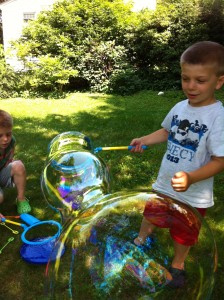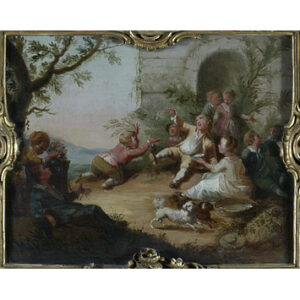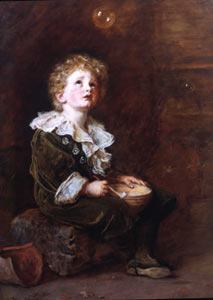Teach Through Play ~ The Story of Bubbles…

WHAT are Bubbles: Bubbles are spherical, filmy structures made of soap, blown from a ribbed wand-on-a- stick and carried with the wind.
But that’s a kind of technical definition for what Bubbles really are ~ magical, floating balls of light-filled prisms.
WHO invented Bubbles, and WHEN: You might say that Moms invented Bubbles. Why? Because Moms have always known that children are entertained by laundry and washing-hands-and-dishes soap bubbles.
There is an 18th century Italian painting (artist unknown) depicting the fun and wonder of children blowing Bubbles –
 Then there’s the 19th century painting by Sir John Everett Millais, entitled Bubbles, made famous for its use in advertisements for Pears Soap. Bubbles shows a boy blowing bubbles with a pipe and a bowl of soap suds.
Then there’s the 19th century painting by Sir John Everett Millais, entitled Bubbles, made famous for its use in advertisements for Pears Soap. Bubbles shows a boy blowing bubbles with a pipe and a bowl of soap suds.

The beginning of the 20th century blended kids’ fascination with Bubbles and the toy world when street peddlers began to sell Bubbles.
But Chem-Toy, a chemical company that sold cleaning products, would be the first to revolutionize the world of Bubbles during the 1940′s by selling Bubbles in small containers under the Mr. Bubbles name (not to be confused with Mr. Bubble, the bath products.)
WHERE are Bubbles used: Everywhere people gather to have fun out-of-doors.
Today, you can buy Bubbles just about anywhere.
Join in on the Bubbles fascination with your kids and grandkids. Add a little history to your Bubbles by experimenting with different sized and shaped wands; some creating gigantic bubbles, bubbles within bubbles or even rapid-fire bubbles. You may even want to grab some clay pipes, corncob pipes or old (clean) tobacco pipes and a bowl of soap suds, just as kids used to use!
There are also all kinds of science lessons to be learned from the simple Bubble. Try this one from over at How Stuff Works for a little color:
The iridescent colors of a soap bubble are produced by the interference of light, which is the effect caused by the joining together of two waves of light. Light reflected from the outer surface of the film combines with that reflected from the inner surface. The shimmering effect is caused by the changing thickness of the film.
A trip to the library or the internet may be in order!



